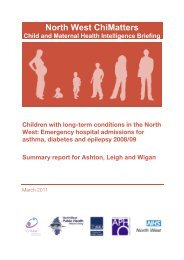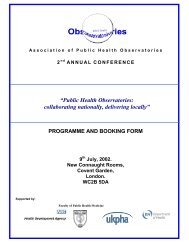9261 HEPATITIS C REPORT GALLEY - North West Public Health ...
9261 HEPATITIS C REPORT GALLEY - North West Public Health ...
9261 HEPATITIS C REPORT GALLEY - North West Public Health ...
Create successful ePaper yourself
Turn your PDF publications into a flip-book with our unique Google optimized e-Paper software.
1. INTRODUCTION<br />
1.1 Background<br />
Viruses such as the human immunodeficiency virus (HIV), hepatitis C and hepatitis B<br />
that are transmitted through blood pose a major health threat particularly for people<br />
who inject drugs. Amongst these viruses, hepatitis C represents a growing concern for<br />
several reasons. Firstly, previous studies in the UK and Ireland suggest that its<br />
prevalence is extremely high among injecting drug users (IDUs) (between 60% and<br />
90%: Smythe et al.1998; Goldberg et al. 1998; Lamden et al. 1998; Best et al. 1999).<br />
Secondly, unlike for hepatitis A and B, no vaccine is as yet available, and the rapid<br />
mutation rate of the hepatitis C virus makes the imminent development of one<br />
unlikely (Liang et al. 2000). Thirdly, a high proportion of cases (around 80%) become<br />
chronically infected, and of these, around 20% go on to develop serious liver damage,<br />
such as cirrhosis or hepatic carcinoma (Theodore & Fried 2000). Finally, current<br />
treatment is often ineffective, with even the most advanced treatment available<br />
clearing the infection on only 40% of occasions (Liang et al. 2000).<br />
Key objectives in the Government's ten year drug strategy Tackling Drugs to Build a<br />
Better Britain (1998) include increasing the number of users entering treatment<br />
programmes, reducing the number of young people using drugs and reducing the<br />
levels of injecting and sharing of equipment. If these targets are met, the number of<br />
new hepatitis C infections would decrease. However, currently there are large numbers<br />
of users in the <strong>North</strong> <strong>West</strong> who share equipment who are either infected with hepatitis<br />
C or at risk of infection (see Section 1.4). The exact scale of the problem is difficult to<br />
assess as individuals typically have many years of asymptomatic infection before<br />
presenting to health services with chronic disease. What is clear though, is that the<br />
high prevalence among IDUs currently accessing drug treatment services suggests<br />
considerable future health care costs in treating the expected associated rise in liver<br />
failure and associated morbidity (Leal et al. 1999), as well as the health and social costs<br />
of prolonged morbidity and disability to those infected with hepatitis C (Dolan 1997).<br />
1.2 Transmission<br />
Hepatitis C is primarily transmitted through blood. Prior to screening of blood<br />
donations, recipients of blood transfusions or blood products were at risk of infection.<br />
As a result, an estimated 4000 haemophiliacs in the UK have been infected through<br />
blood products (The Haemophilia Society 1999) and the total number of people<br />
infected through blood or blood product transfusion and organ donation is estimated<br />
to be around 7500 (Syed & Snee 1997; CDSC <strong>North</strong> <strong>West</strong> 1999). The risk of infection<br />
through this route dropped dramatically with the introduction of effective heat<br />
treatment in 1986 (1987 in Scotland) (The Haemophilia Society 1999). The risk then<br />
dropped further with the introduction of hepatitis C antibody screening in 1991.<br />
The group now at the highest risk is IDUs.<br />
8<br />
H EPATITIS C IN INJECTING DRUG USERS IN THE N ORTH W EST











